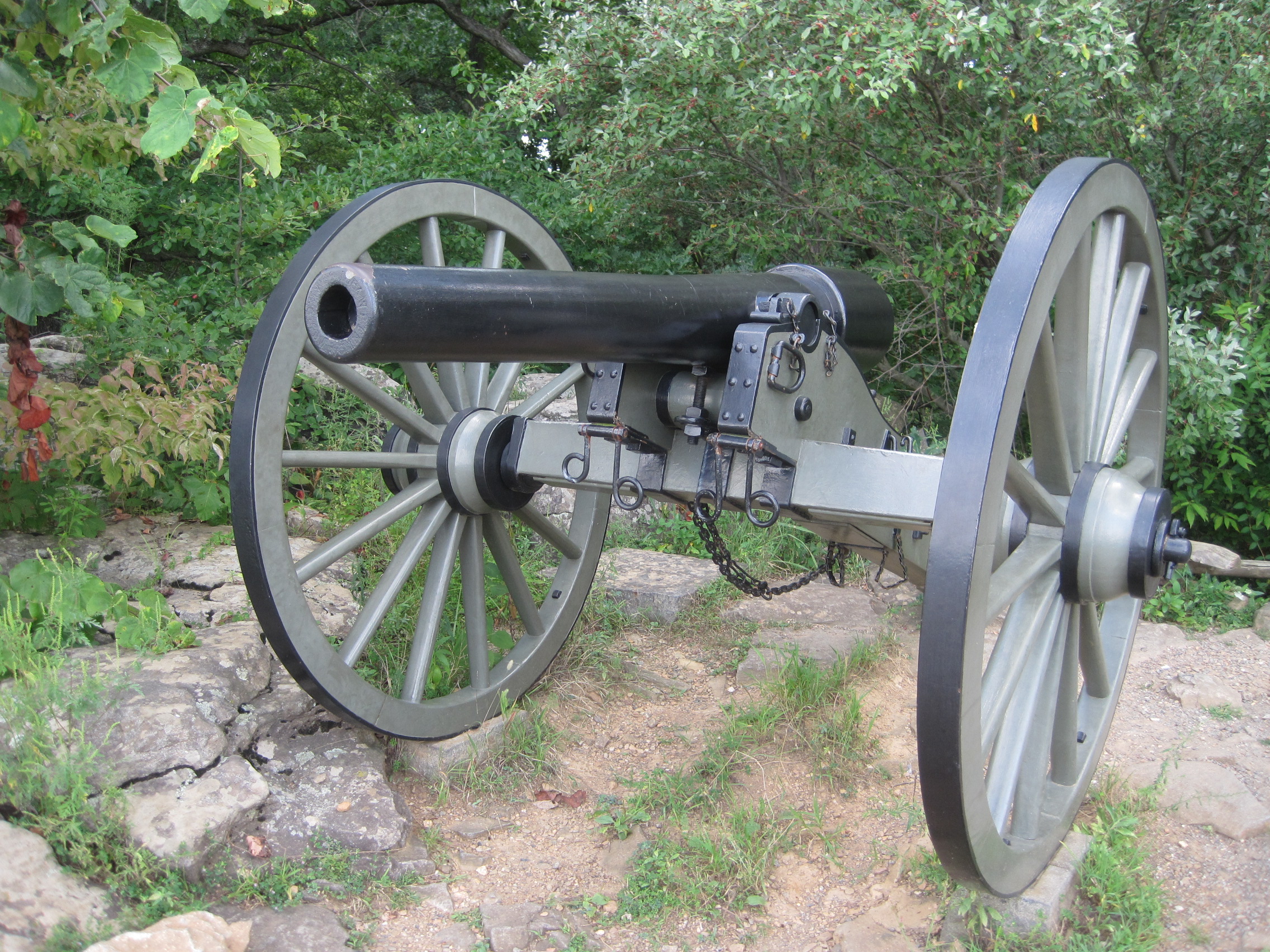The Round Table received a thank you for the honorarium we presented Christ Heisey last month and which he requested be turned over to the trust….
Protect America's Battlefields - Support the "Preserving America's Battlefields Act"
Dear Friends,
Last year, with your help, the Trust made incredible progress in Congress to preserve America’s hallowed grounds.
For the first time in history, the House of Representatives voted to reauthorize the federal Battlefield Land Acquisition Grants Program at $15 million. While the Senate was unable to likewise advance reauthorizing legislation before the end of the year, your efforts moved the ball farther than ever before. Dozens of representatives and senators are now on record in support of preserving our nation's battlefields — thanks to you!
I am pleased to report that we now have a chance to pass a bill that will ensure this program remains one of the strongest weapons in our arsenal for years to come! Just days after the start of the new Congress, Rep. Jody Hice of Georgia, together with a bipartisan coalition of House members from across the country, reintroduced the Preserving America's Battlefields Act, H.R. 307. Sens. Johnny Isakson of Georgia, Tim Kaine of Virginia and Roy Blunt of Missouri are championing an identical companion bill in the Senate, S. .225.
This legislation would reauthorize the Battlefield Land Acquisition Grants Program at $20 million annually. Further, for the first time, it would provide funding to restore and interpret battlefield sites following their preservation — making them the outdoor classrooms we all know they ought to be.
As I've said before, our cause has benefited from tremendous partners in government, including the United States Congress and the National Park Service. Their institutional, bipartisan support for battlefield preservation has resulted in the continued success of the Battlefield Land Acquisition Grants Program. The matching grants awarded through this program have enabled the American Battlefield Trust and other nonprofit groups to save more than 30,000 acres of battlefield land at sacred places like Antietam, Brandywine, Fort Donelson, Gettysburg, Princeton, Richmond and Vicksburg.
It is imperative that your elected representatives in Washington, D.C., hear from you! Please take a moment to write your members of Congress and ask them to cosponsor the Preserving America's Battlefields Act, S.225 and H.R. 307. Our online advocacy tool is simple, and sending a letter only takes a few minutes.
Let your representative and senators know that — as a constituent — this issue is important to you, and you would like their support. With the approaching 250th anniversary of America's War of Independence, there is no better time than now to pass this landmark legislation. Thank you, now as always, for your support for battlefield preservation!
'Til the battle is won,
Jim Lighthizer
President
American Battlefield Trust
P.S. Your voice is needed! Please write your members of Congress in support of battlefield preservation. Our online tool is simple and sending a letter only takes a few minutes.
Shenandoah Valley Battlefields Foundation Endorses I-81 Improvement Legislation
Battlefields Foundation Endorses I-81 Improvement Legislation
Interstate Passes Through 7 Major Battlefields in the Shenandoah Valley
NEW MARKET, Va.— January 22, 2019 - Today the Shenandoah Valley Battlefields Foundation (SVBF) announced its strong endorsement of the Interstate 81 improvement legislation that is currently under debate in the Virginia legislature. Interstate 81 passes through 7 major battlefields in the Valley, among them New Market, Fisher’s Hill, Cedar Creek, and Third Winchester, so discussions and legislation regarding the future of the interstate directly impact and greatly concern the Battlefields Foundation.
Changes to the interstate have the potential to dramatically affect not just the preservation and interpretation of the battlefields, but also their ability to draw tourists to the Valley. The battlefields draw hundreds of thousands of visitors to the region each year, making them huge economic assets.
“We really appreciate the effort that our legislators and Governor Northam’s Department of Transportation put in to this plan,” said Keven M. Walker, Chief Executive officer of the Shenandoah Valley Battlefields Foundation (SVBF). “The legislation as proposed will address many of the problems drivers face on I-81, and improve driver safety, while causing the least negative impact on the Shenandoah Valley and its battlefields.”
On January 15th, Valley legislators introduced bills implementing the results of the Virginia Department of Transportation’s (VDOT’s) year-long I-81study. The two identical bills, House Bill 2718 (patrons are Delegates Landes and Austin) and Senate Bill 1716 (patrons are Senators Obenshain and Carrico), create the “Interstate 81 Corridor Improvement Program and Fund.”
The bills would authorize tolls on cars and trucks to raise money for the $2.2 billion list of I-81 improvements in Virginia. The bills set the toll for commercial trucks at 17 cents a mile and up to 11 cents a mile for everyone else. Tolls would be cut in half from the hours of 9:00 PM and 6:00 AM to encourage drives to shift their trips to times when the road is underutilized. Tolls would be collected electronically (no toll booths). An annual commuter pass will be available, not to exceed $32.35/year. The legislation also blocks additional sales taxes or gas taxes in the corridor while tolls are in effect.
The bill creates a 13-member committee, made up of elected and appointed officials in the I-81 corridor, to guide project development and oversee possible toll increases in the future.
“This legislation includes many of the things we’ve been advocating for more than a decade,” said Walker. “Instead of unpopular wholesale widening, the legislation funds a list of targeted improvements, backed by safety data and public input. Plus, it requires consideration of environmental and historic resources when ranking projects.”
According to SVBF, the problems on I-81 are not simple, and workable solutions cannot be either. The legislation allows improvements to the I-81 corridor which includes parallel roads and rail. It also would fund operational improvements like speed enforcement and cracking down on distracted driving, clearing accidents more quickly, and using technology to alert drivers to upcoming problems.
“Tolls are always controversial,” Walker said. “But compared to the alternatives, tolls make the most sense. And the legislators have come up with a thoughtful forward-looking approach.”
One truck does the damage of 5,600 cars, according to the I-81 Corridor Improvement Plan, so it makes sense that trucks would pay a greater share. While all drivers pay for use of the highway, those who are the heaviest users and have the greatest impact pay more of the costs.
“There is definitely room for improvement” according to Walker. “For one, the solutions are overly reliant on asphalt, with more than 58 miles of new pavement in the VDOT Staunton District alone.” The plan needs more flexibility for rail improvement (to get the long-haul trucks off the highway) and transit (like the popular new Virginia Breeze bus service), Walker added.
A Letter to Allentown City Council and the Morning Call
by Frank Whelan (a CWRT Board member)

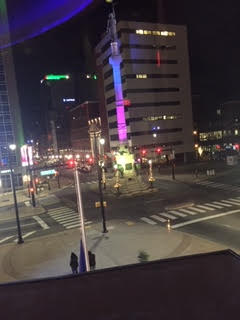

There are many things that have changed in downtown Allentown lately, a lot of it for the better.
But there is one thing I find offensive, the multi colored lighting used on the Center Square Soldiers and Sailors monument.
While that kind of lighting is fine for the new office buildings it is rather garish, gaudy and tasteless when applied to a 19 th century community icon that represents not just the soldiers of sailors of the Civil War, its original purpose, but those of all wars.
This does not mean that I think the monument should go unlighted. White lights that are directed at the statues of the soldiers and sailors themselves around the base would not only be appropriate but also respectful of the heritage, that I as a member of the board of the Civil War Roundtable of Eastern Pennsylvania and my fellow members cherish.
I respectfully request that Lehigh County authorities as guardians of this treasure that represents the sacrifices of so many make this change that would not only enhance respect for the monument itself but also honor those who will serve their country in the future.
Apologize, v – To lay the foundation for a future offence. (D.D.)
A Message of Thanks from the American Battlefield Trust
On October 3, 1863, President Lincoln issued a proclamation designating "the last Thursday of November next, as a day of Thanksgiving." A year later, citizens would organize a special Thanksgiving dinner for Federal soldiers and sailors to show the public's appreciation for their service and sacrifice.
Today, I'd like to share my appreciation for you. Thanks to your support this year, we crossed the thresholds of 50,000 acres preserved for future generations and 20,000 students sent to battlefields and historic sites through our Field Trip Fund. We preserved hallowed ground at Princeton, Gettysburg and Yorktown and were chosen to help lead the 250th commemoration of the founding of the United States.
If you have two minutes today, please watch the Trust's year in review video for a brief summary of all the incredible things you made possible in 2018. Of course, two minutes isn't nearly enough time to express my awe and gratitude for your dedication to battlefield preservation – but it's a start!
Simply put, the successes of this year would not have been possible without your generosity. Whatever you're doing on this day of thanks, please know how much your support means – not just to me and my colleagues, but to generations of Americans, present and future. From all of us at the Trust, warmest wishes for a very Happy Thanksgiving.
With deepest gratitude,
Jim Lighthizer
President
American Battlefield Trust
P.S. I hope you are enjoying this day of thanks with your friends and family. This two-minute video summarizes all of your accomplishments in 2018. Thank you for your steadfast support.
Civil War Trust Sends Thank You's for Donations to Battlefield Preservation
One of the missions of the Civil War Round Table of Eastern PA is the preservation of historic battlefields. Each year we donate thousands of dollars to assist with this effort.
Here are some of the latest thank you’s we have received for preservation efforts at:
~ Shiloh, Glendale & Fredericksburg - $1.000.00
~ Slaughter Pen Farm at Fredericksburg - $1,000.00
~ Fort Donelson - $1,000.00
~Shenandoah Valley Battlefields Foundation - $1,000.00
~ Fort Donelson & Parker’s Cross Roads

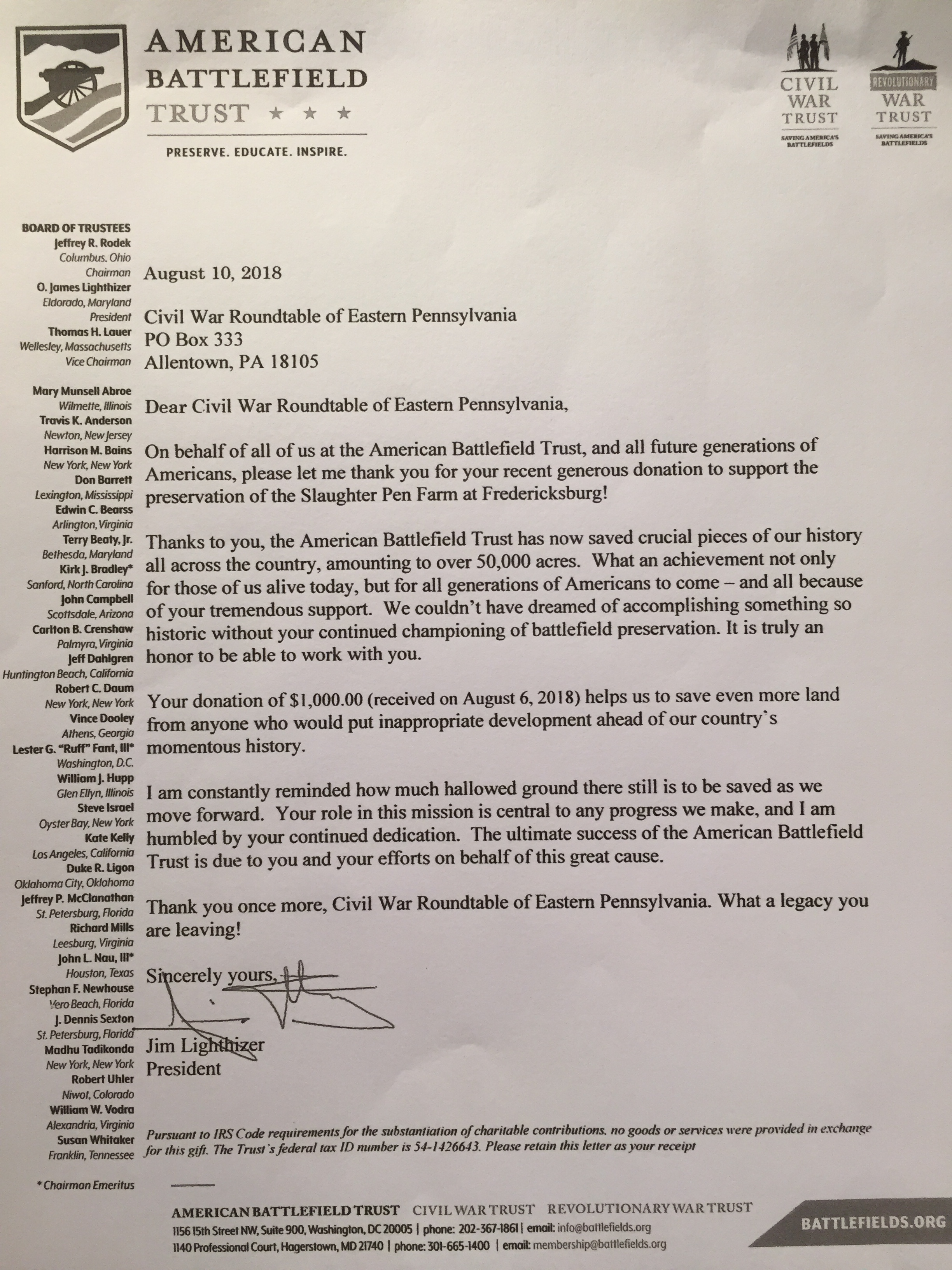
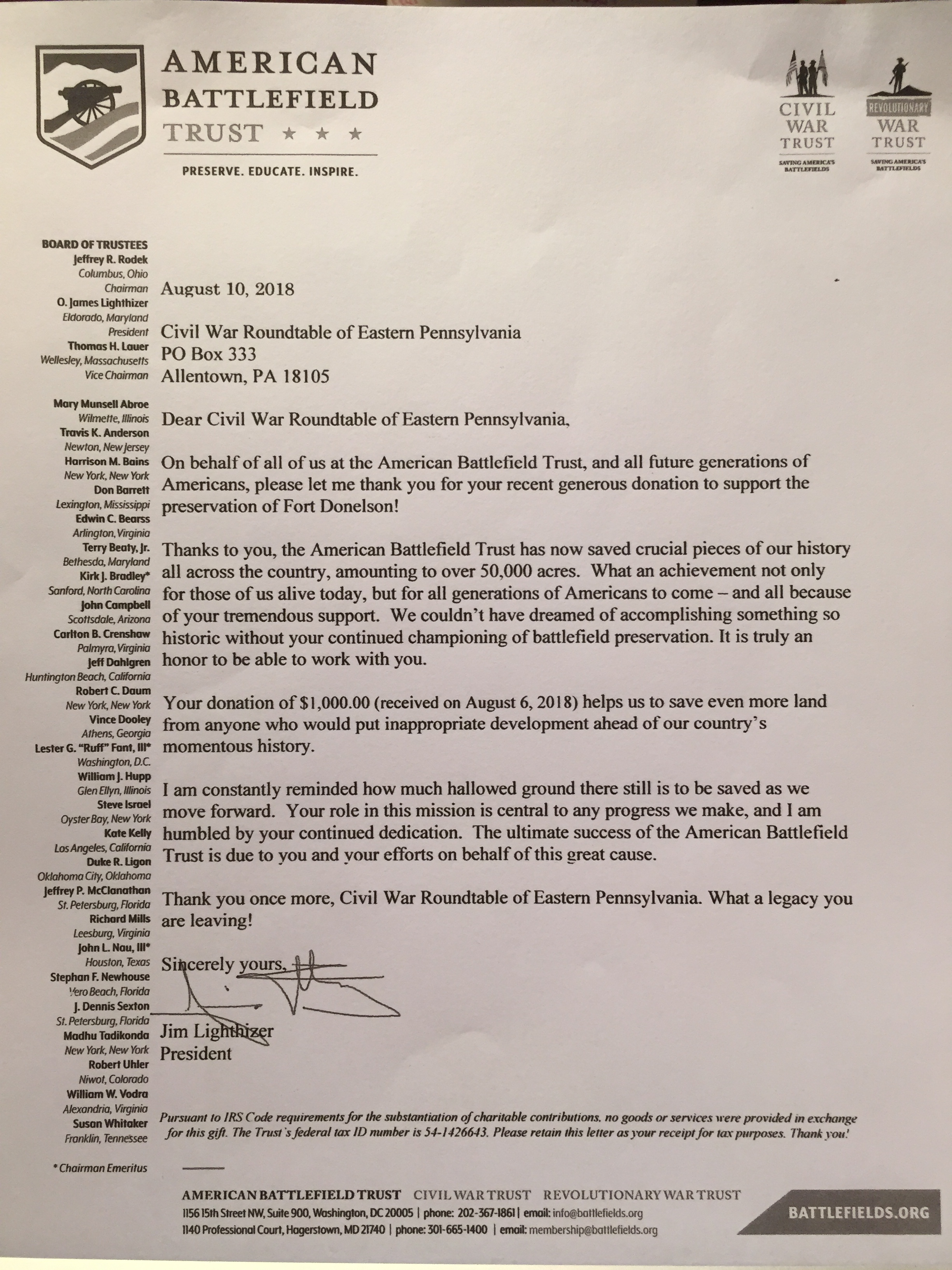
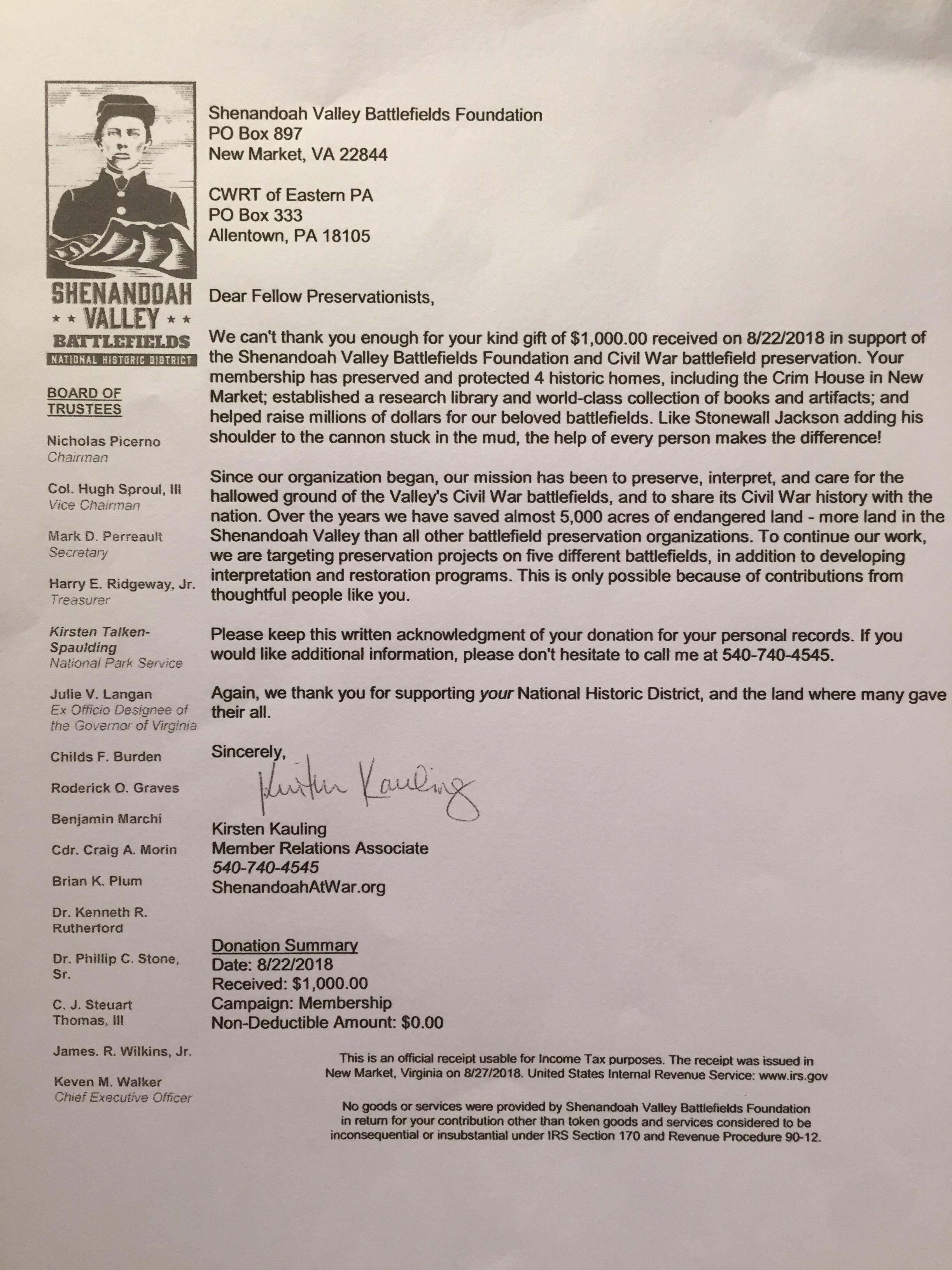
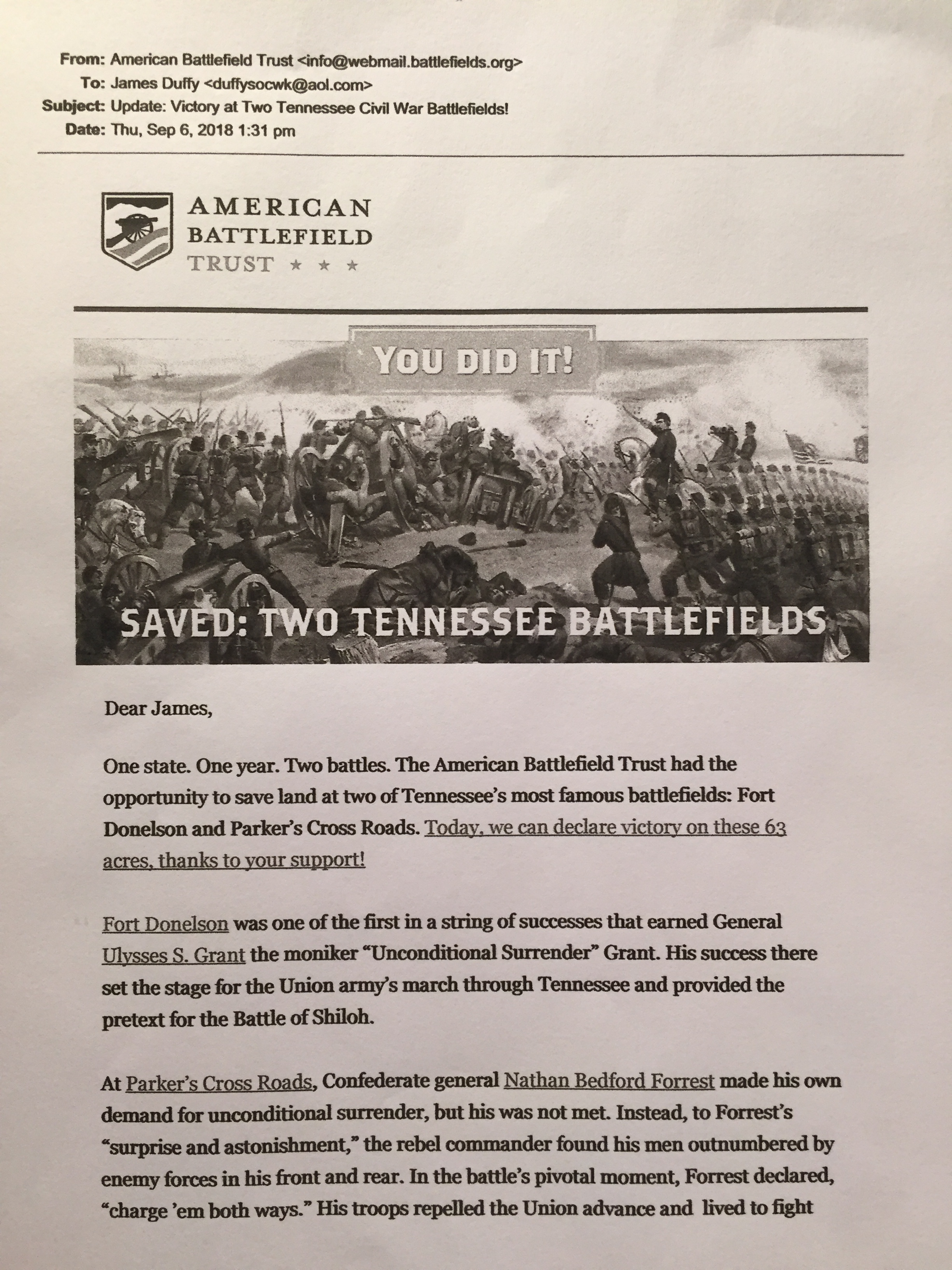
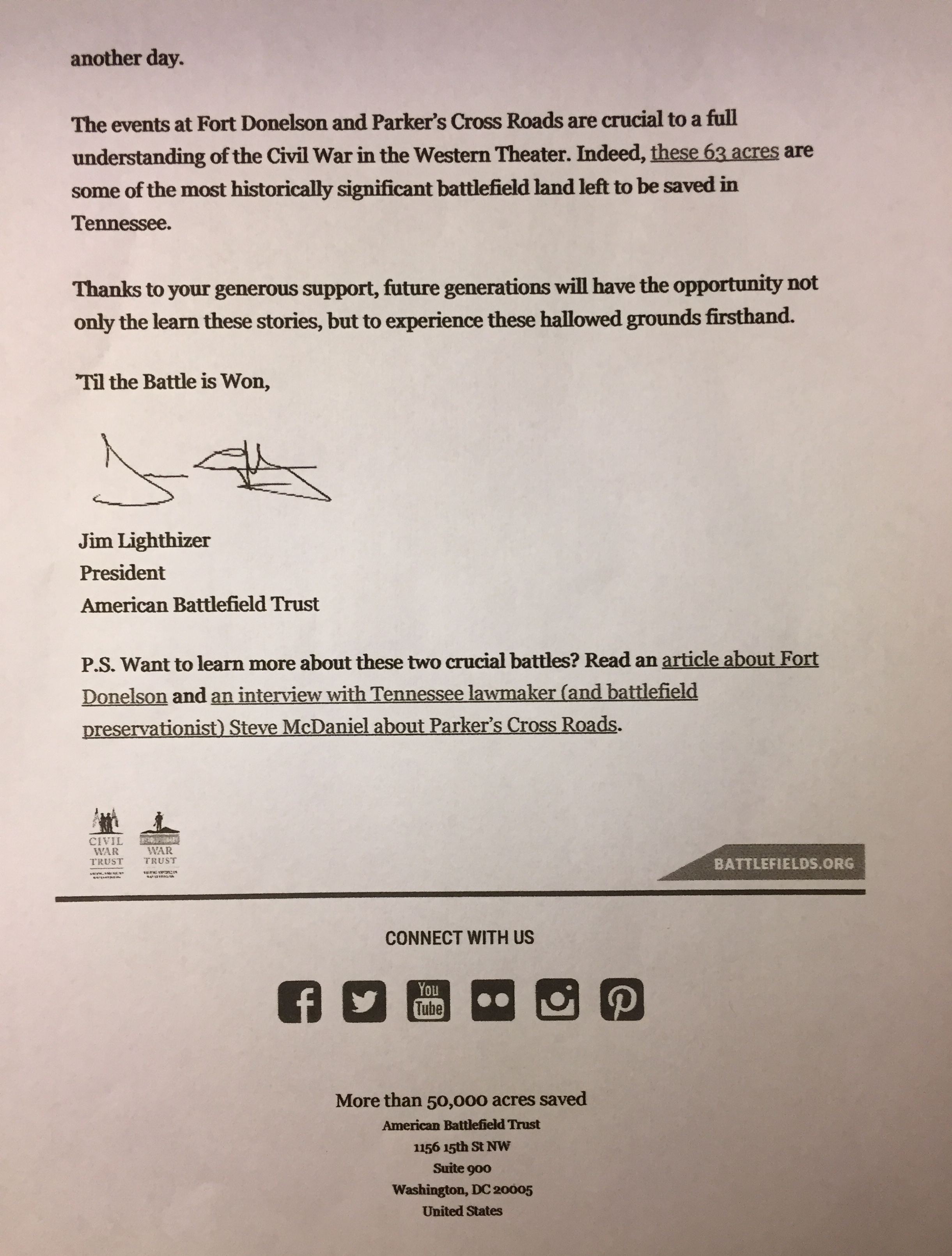
Shenandoah Valley Battlefields Foundation sends thanks for preservation donation
PA House Unanimous in Adding to GBPA Camp Letterman Preservation Drive
Pennsylvania House Unanimous in Adding to GBPA Camp Letterman Preservation Drive
The Pennsylvania House of Representatives voted unanimously Thursday to adopt a resolution (H.R. 998) honoring the Camp Letterman General Hospital established in the weeks following the massive Civil War battle in Gettysburg.
At Letterman, thousands of wounded Confederate and Union troops were gathered from area homes, barns, churches and other buildings throughout the area and provided the best care available at the time. The massive tent hospital named for Dr. Jonathan Letterman, medical Director of the Army of the Potomac, was the first to consolidate care for wounded and dying of both sides following a battle.
The House resolution comes at a time when the Gettysburg Battlefield Preservation Association is crusading to preserve the remaining property where Camp Letterman was located south of York Road.
The resolution was sponsored by Rep. Dan Moul, R-Adams, and co-sponsored by Rep. Harry Readshaw, D- Allegheny.
The remaining 17-acres of Camp Letterman property is threatened by a planned 191-acre townhouse development by S & A Homes of State College, Pennsylvania.
The GBPA has been supported in asking S & A Homes to set-aside the 17-acres by a letter-writing campaign by people from at least 35 states, 3 foreign countries, preservation organizations, individual living historians and authors, civil war round tables, civil war organizations and other living history groups.
The State of Vermont made its support of the GBPA effort official. In May, the Vermont Senate and House of Representatives adopted a resolution that states “the General Assembly supports the Gettysburg Battlefield Preservation Association‘s effort to preserve the Camp Letterman hospital site and requests that S & A Homes Set aside these 17 acres of historic ground.”
Camp Letterman was administered by Dr. Henry Janes, a Waterbury, Vermont, physician and U.S. Army surgeon.
GBPA President Barb Mowery noted the bipartisan support for the Camp Letterman resolution in in the Pennsylvania state House and hopes a similar resolution will also emerge from the Senate.
“We are not trying to stop the entire 191-acre townhouse development by S & A Homes,” said Mowery. “We are appealing to their patriotism and asking that they shave off the 17 acres that were part of Camp Letterman.”
Mowery said representatives of the GBPA, founded in 1959 to preserve remaining Gettysburg battlefield land from commercial and residential development, have met with S & A representatives on a number of occasions, but have received no assurances that the Letterman ground won’t be plowed up and paved for roads and residences.
Supporters of the GBPA Letterman preservation campaign are asked to send letters to: S & A Homes; ATTN: Bob Poole, Pres. & CEO; 2121 Old Gatesburg Road, Suite 200, State College, PA 16803
Click here to view the resolution.
Legendary Historian Edwin C. Bearss Recognized For Lifetime Achievements By American Battlefield Trust
Legendary Historian Edwin C. Bearss Recognized For Lifetime Achievements By American Battlefield Trust
Renowned historian and storyteller lauded for extraordinary contributions to battlefield preservation and interpreting America’s past
June 2, 2018
(Newport News, Virginia) – Edwin Cole Bearss, chief historian emeritus of the National Park Service, was presented Thursday with the American Battlefield Trust’s inaugural Lifetime Achievement Award, for his many decades dedicated to researching and relating the nation’s past to millions of people, as well as his advocacy for battlefield preservation.
The honor is the first to be awarded by the American Battlefield Trust. The nonprofit organization dedicated to preserving America’s hallowed battlegrounds and educating the public about their unique role in our nation’s history. Trust President O. James Lighthizer presented the award to Bearss at an emotional ceremony during the group’s annual conference this week in Newport News.
Bearss was one of the stars of Ken Burns’ award-winning PBS TV series “The Civil War,” which introduced generations to the compelling subject of the nation’s deadliest conflict. Thousands more people have enjoyed the historian’s unique tours of historic sites associated with the Civil War; the American Revolution; World War I and World War II in Europe; Abraham Lincoln’s assassination; and the American West, delivered at a brisk pace and in his distinctive baritone voice.
“Ed Bearss, the best battlefield guide you’ll ever find, is widely recognized as the nation’s premier storyteller of the American Civil War,” Lighthizer said. “Ed's encyclopedic knowledge and passion for history has inspired countless people to preserve battlefield landscapes, visit historic sites in the U.S. and abroad, and learn about the past.”
U.S. Congressman Robert C. “Bobby” Scott of Virginia’s 3rd House District, and Dan Smith, Deputy Director of the National Park Service, were also present during the ceremony. Noting his long association with Bearss, Smith remarked, “My day was made today when Ed Bearss walked into the room.”
The Trust’s Edwin C. Bearss Lifetime Achievement Award was first presented in May 2001 when the organization was known as the Civil War Preservation Trust. Now, as the American Battlefield Trust, the organization decided to rededicate its most prestigious award by recognizing its namesake. The nonprofit is also creating a Battlefield Preservation Hall of Fame, with Bearss inducted as its first member.
In addition, Lighthizer said the Trust will erect a granite monument to Bearss on the Vicksburg Campaign’s Champion Hill battlefield in Mississippi, with a bronze plaque that will include his portrait. Original scholarship by Bearss has helped modern historians better understand the pivotal role this May 16, 1863, battle played in determining the course of the Civil War.
Bearss, who will mark his 95th birthday in June, is a Marine veteran of World War II and the son of a Marine veteran of World War I. As a member of the 3rd Marine Raider Battalion, Bearss was wounded at Suicide Creek, New Britain, by Japanese machine-gun fire during the Pacific Campaign of 1944.
After a lengthy recuperation, Bearss earned a bachelor’s degree in Foreign Service studies from Georgetown University and a master’s degree in history from Indiana University. He had been fascinated by history since his boyhood on his family's E Bar S ranch near Billings, Montana, where he named cows for Civil War generals and battles.
During his master’s thesis research, a visit to Shiloh National Military Park convinced Bearss that it was vital for people to merge their study of the Civil War with examining and understanding the terrain upon which battles were fought. He told friends: “You can’t describe a battlefield unless you walk it.” That visit sparked his interest in a career with the National Park Service.
For many years, Bearss was the historian at Vicksburg National Military Park. There, he found and raised the USS Cairo ironclad from the Mississippi River. The gunboat sank in 12 minutes on Dec. 12, 1862. Today, you can see the remains of the vessel on display at the park.
Bearss served as chief historian of the National Park Service from 1981 to 1994 and became special assistant to the agency’s director in 1994. He is the author of many magazine articles and books, including Fields of Honor: Pivotal Battles of the Civil War, and Receding Tide: Vicksburg and Gettysburg – The Campaigns That Changed the Civil War. Bearss’ influence on battlefield preservation has been profound. His prominent role in national controversies over development near Manassas National Battlefield Park is told in historian Joan M. Zenzen’s book Battling for Manassas.
Bearss was not the only battlefield preservation champion recognized during the Trust’s annual conference. On Thursday evening, the Trust presented its Shelby Foote Preservation Legacy Award to philanthropist and battlefield advocate Mark Perreault, a longtime member of the organization, in recognition of his years of extraordinary support for battlefield preservation in Virginia and throughout the nation.
Former legal counsel of Norfolk Southern Corp., Perreault led the grassroots effort to create Fort Monroe National Monument in Hampton. He is now working with the Trust and the Richmond Battlefields Association to preserve the Second Deep Bottom battlefield near Richmond, and he and his wife, Karen, are restoring an antebellum house at Fussell’s Mill there. He is also a strong advocate for the preservation of Petersburg National Battlefield, and supported legislation enacted by Congress in 2016 that expanded the park’s authorized boundary.
“Mark has stepped up again and again, responding to every appeal, and also lending a hand with special projects. He has given hundreds of times to the Trust,” Lighthizer said. “He is a pace-setter, no question about it.”
The Trust presented its Brian C. Pohanka Preservation Organization Award to the Save Historic Antietam Foundation (SHAF), a nonprofit group established in 1996 to preserve more of the Antietam battlefield’s landscape in a fast-growing part of the Washington metropolitan area. SHAF has conserved more than 3,000 battlefield acres in the Sharpsburg, Md., area, restored historic sites, and helped reforest the Antietam battlefield’s wartime North Woods, East Woods and West Woods. Dr. Tom Clemens, SHAF’s president, and SHAF co-founder Dennis Frye, former historian at Harpers Ferry National Historical Park, accepted the award on the group’s behalf.
The Trust also presented the Pohanka Award to Civil War Trails Inc., a nonprofit group based in Williamsburg, Va., that helps travelers find, understand and enjoy Civil War sites in five states — Virginia, Maryland, West Virginia, Tennessee and North Carolina. Last year, it distributed more than a quarter million maps to localities, tourism offices and other partners, seeing greater demand than during the Civil War’s 150th anniversary. Drew Gruber, executive director of Civil War Trails, accepted the award for the organization.
The American Battlefield Trust is dedicated to preserving America’s hallowed battlegrounds and educating the public about what happened there and why it matters today. The nonprofit, nonpartisan organization has protected more than 50,000 acres associated with the Revolutionary War, War of 1812, and Civil War. Learn more at www.battlefields.org.
Announcing: "The American Battlefield Trust"
The Civil War Trust announced this morning a new identity to better reflect its expanding mission: The American Battlefields Trust. The new umbrella organization will encompass the organization's efforts to save battlefields from the Revolutionary War, the War of 1812, and the Civil War.
"The Civil War Trust isn’t going away," the Trust said in making its announcement. "[I]t remains the principal division of the American Battlefield Trust. You’ll continue to see its name and logo whenever we announce a new acquisition opportunity at a Civil War battlefield."
Save Three Virginia Battlefields!
Save Three Virginia Battlefields!
The Civil War Trust is now working to preserve 326 more acres of hallowed ground at three battlefields in Virginia: Second Manassas, North Anna, and New Market Heights.
At Second Manassas, we are adding 167 acres to the more than 200 acres we have already preserved there—and preventing the construction of McMansions on a key piece of hallowed ground. Further south, we have the opportunity to open previously inaccessible battlefield land at North Anna and New Market Heights, both scenes of important action in the 1864 campaigns to take the Confederate capitol in Richmond.
Virginia was the most fought-over state in America during the Civil War. Between the early clash at Manassas in 1861 to the ultimate fall of Richmond in 1865, more than 120 battles and skirmishes were fought within the borders of the Old Dominion, each of them an important chapter in our nation’s defining conflict. It’s little wonder the Civil War Trust and its supporters have saved more than 24,000 acres of battlefield land in the Commonwealth.
Help Save Three Virginia Battlefields!
LOCATION
New Market Heights Battlefield
DONATION MATCH - $33.42 to $1
OUR GOAL - $167,900
A 158 Acres Preserved at Cedar Creek Battlefield in Virginia
A 158 Acres Preserved at Cedar Creek Battlefield in Virginia
During its Annual Meeting on Saturday evening, the Shenandoah Valley Battlefields Foundation announced a new preservation victory - the preservation of 158 acres on the Cedar Creek battlefield.
The 158 acre parcel, which lies in Warren County, was part of the Confederate attack on the morning of the Battle of Cedar Creek on October 19, 1864. Confederate General John B. Gordon's troops swarmed over this property under the cover of darkness as they began their surprise assault on the unsuspecting Federal lines.
A Family's Generosity
The preservation was made possible by the generosity of landowner Tunstall C. "Joe" Powers, Jr. and his wife Linda E. Powers, who donated the conservation easement on their property. "Our family welcomes this opportunity to partner with Warren County and the Battlefields Foundation in order to preserve the historic and scenic values of our farm," Mr. Powers said. "My father grew up in Strasburg and was aware of the fords on the property and their role in the Confederate's early morning advance at Cedar Creek. My mother enjoyed the vistas of Signal Knob and the variety of wildlife that inhabit the farm. We believe that a conservation easement can insure the enjoyment of this property by future generations."
"The Powers family has already helped to preserve hundreds of acres of the Cedar Creek battlefield," said SVBF CEO Keven M. Walker, "And this act of extreme generosity forever ensures their legacy as one of the most instrumental families for battlefield preservation the Valley has ever known.
Warren County's Pivotal Partnership
"The Battlefields Foundation is also grateful for the partnership of the Warren County Board of Supervisors and staff in this preservation effort" SVBF Conservation Director John Hutchinson said. "The county co-holds the easement and shares responsibility with the Foundation for seeing that the property is protected in perpetuity."
SVBF Has Saved 873 Acres at Cedar Creek - and Manages 938
Since 2000, the Shenandoah Valley Battlefields Foundation has preserved 873 acres on the Cedar Creek battlefield, more than any other preservation organization. The SVBF also holds an additional 65 acres that was originally preserved by the Civil War Trust and given to the SVBF in 2015; in all, the SVBF manages 938 acres of the Cedar Creek battlefield.
Confederate Gen. John B. Gordon
Site of the Daring Morning Attack
The preserved 158-acre property was part of the very beginning of the Battle of Cedar Creek; it was across this land that Confederates under Gen. Joseph Kershaw and Gen. John. B. Gordon launched their daring pre-dawn assault on the morning of October 19, 1864, the first blow in Confederate commander Gen Jubal A. Early's brilliant surprise attack. Kershaw and Gordon's men swarmed out of the fog to crash into Union Col. Joseph Thoburn's division (part of the Union Army of West Virginia, aka the VIII Corps). While Thoburn's position was "crowned with a formidable line of entrenchments," it was isolated from the other Union defenses, and his men were overwhelmed by the southerners (including Gen. William T. Wofford's brigade of Georgians), beginning the domino-like collapse of the VIII Corps.
Despite the stunning success of the Confederate attack that morning, the Federals would counterattack in the afternoon and turn the day into a crushing Union victory. Cedar Creek was the final battle of Union Gen. Philip Sheridan's 1864 Shenandoah Campaign, climaxing a series of victories that gave Union forces permanent control of the Valley and helped ensure Abraham Lincoln's reelection that November.
A Viewshed Preserved
"And this property is important not just for its historical value, but also for how it affects the surrounding battlefield," added Walker. "Keeping this land undeveloped is critical for protecting the viewshed and the historic integrity of surrounding property that has already been preserved."
National Park Service Begins Roof Replacement, Masonry Repair At Lincoln Memorial
National Park Service Begins Roof Replacement, Masonry Repair At Lincoln Memorial
By NPT Staff on January 9th, 2018
An eight-month-long project is under way to make repairs to the Lincoln Memorial on the National Mall in Washington/NPS
The National Park Service has begun an eight-month project to replace the roofs and repair cracked marble at the Lincoln Memorial in Washington, D.C. The memorial will remain open for the duration of the project, though some areas will be inaccessible.
The flat upper and lower roofs of the memorial were last replaced 20 years ago and are starting to fail. Incoming water is staining the interior walls of the memorial, most noticeably on the southeast wall. A sound roof is one of the most important ways to protect and preserve a historic building, and the new roofs will be constructed with five layers to keep the interior dry and watertight. From interior to exterior, the roofs will be composed of: hollow clay terracotta tile, concrete decking, a hot rubberized asphalt membrane, rigid insulation and slate pavers.
The project will also repair the white marble at the (click here to read the entire article)
Scrapped housing development a sign of hope for hallowed Brandywine Revolutionary War Battlefield in Chester County
Brandywine Battlefield 1, Free Markets 0: Scrapped Chester County housing development a sign of hope for hallowed Revolutionary War site
by Maria Panaritis, Regional Columnist @panaritism | mpanaritis@phillynews.com
Click here to read original article
It was a firefight so consequential that the British sent Gen. George Washington and his troops fleeing and captured Philadelphia just two weeks later. Philly also lost its status as the nation’s capital because of it.
In the annals of local and American history, in other words, the daylong Battle of Brandywine in 1777 was one of the largest of the Revolutionary War. But measured by national parks, monuments, and museums, Brandywine is the forgotten stepchild of the war that introduced the world to modern-day democratic rule.
Until, quite possibly, now.
A few days before New Year’s, residents of Westtown Township, Chester County, cheered as their elected officials spiked a planned Toll Bros. housing development on a 322-acre privately owned parcel known as Crebilly Farm, where portions of the famous battle were believed to have been waged.
Township supervisors felt no need to disclose the reasoning behind their unanimous vote. A written statement is expected in the next few weeks. But the town a decade earlier had OK’d a different development at Crebilly and now decided this one was a no-go.
The rejection comes just a few months after reenactors celebrated the Battle of Brandywine’s 240th anniversary — and the preservation purchase of another hallowed patch, Dilworth Farm, for $850,000 with help from the nonprofit Civil War Trust.
The winds of change are finally blowing in the direction of Brandywine finally getting its due. And free-market capitalism is taking a backseat while it does.
What’s unfolding along the Brandywine Creek is a civil version of the tactical strategizing that made the historic battle such a dramatic confrontation.
Just as British Gen. William Howe hatched the plan that ultimately outmaneuvered Washington by landing an armada off the Maryland coast and skulking north toward rebel troops near Chadds Ford, preservationists have stepped up efforts over the past decade to give this diffuse stretch of mostly privately owned hallowed land the protections it has long lacked.
The Dec. 30 ruling was a stunner.
For several decades, Chester County’s gorgeous, rolling farms had been developed into houses faster than you could say, “Pennsylvania’s contracting dairy industry.” (Clue: This used to be dairy country.)
“We were losing a farm in Chester County just about every day in the Eighties and Nineties,” said David Ward, who would know better than most. The assistant director of the county Planning Commission has been at it for 40 years. “Wholesale farms were going up.”
That’s a lot of free-market mania to beat back if you’re a preservationist. Never mind, of course, that a pop quiz would probably reveal a stunning lack of knowledge among even educated locals about the American Revolution. In a nutshell:
Howe led 15,000 British and German mercenary troops into Brandywine on Sept. 11, 1777, from Maryland, where they had landed to launch a surprise attack. They marched east from Kennett Square Borough toward Chadds Ford, where Washington had gathered over 14,000 soldiers and militiamen.
It was so brilliantly executed that Washington retreated to Chester, clearing the way for the British to take their intended prize — Philadelphia.
Nowadays, drive through the Brandywine area and you don’t see much suggesting this ever happened there. You’ll see winding state roads, houses, and purposefully quaint commercial strips.
In neighboring Montgomery County, conversely, Valley Forge National Historical Park is a sprawling, federally owned monument to a less significant chapter in the war’s history.
Near Brandywine, only a sliver of a tiny park along Route 1 is comparably available to the public. The rest of the 35,000 acres on which the battle was fought are spread across 15 municipalities in Chester and Delaware Counties.
No fair.
Until about a decade ago, there wasn’t even universal agreement over the battlefield’s 18th-century boundaries.
That began to change in 2000, when a National Park Service report identified Brandywine as one of the nation’s 30 most-threatened battlefields from that era.
With any luck, the citizen-troops looking to even the preservation score will only further secure its future in the years to come.
Published: January 5, 2018 — 3:01 AM EST | Updated: January 5, 2018 — 6:36 PM EST
http://www.philly.com/philly/columnists/brandywine-battlefield-1-free-markets-0-scrapped-chester-county-housing-development-a-sign-of-hope-for-hallowed-revolutionary-war-site-20180107.html
WE WON A BUFFER AROUND THE HALLOWED GROUND OF GETTYSBURG!
WE WON A BUFFER AROUND THE HALLOWED GROUND OF GETTYSBURG!
THANK YOU FOR YOUR SUPPORT in Saving Gettysburg!
We won! Gettysburg and Adams County finally have a buffer zone against casinos!
Adams County Chooses No Casino: 20 of 21 Townships, 11 of 13 Boroughs opt out of hosting a Casino.
The remaining township, Conewago, votes this Thursday 12/21 at 11AM at 541 Oxford Ave., Hanover, PA. Conewago is next to Hanover and previously decided NOT to opt out but have decided to re-visit their decision. They may not opt out but we are still quite happy with the results.
Statement by No Casino Gettysburg chair Susan Paddock:
Over the last 12 years, the people of Adams County have fought off every category of casino and now have opted out of the PA legislature’s bad idea. We are so grateful that Gettysburg and the hallowed ground surrounding it are protected. No Casino Gettysburg is ready to retire!
Background:
The Pa gambling expansion bill signed 10/31/17 calls for 10 satellite “Category 4” casinos (up to 750 slots and 50 table games) to be awarded to the highest bidder. The auction winner selects their location. The law allows municipalities to opt out of having a casino in their municipality by adopting a resolution before Dec 31, 2017. If they do not opt-out, they will not be able to say no later. However, they can say “yes” later. This action by the borough or township is the only remaining opportunity for municipal leaders to prevent a casino in their neighborhood.
Here are 2 news stories about it. http://www.pennlive.com/politics/index.ssf/2017/12/not_in_my_backyard_if_you_dont.html
No Casino Gettysburg has been fighting casino proposals for the Gettysburg Area since 2005. The first three proposals were from a local developer, David LeVan. In 2005 he proposed a Stand-alone casino in Straban Township. In 2010 he proposed a “resort casino” in the Eisenhower Inn, in Cumberland Township. Neither the first or second proposal ever received a single yes vote from the PGCB. From PGCB reasons for rejecting Crossroads:
“The Gettysburg area itself is primarily a rural area without large population centers nearby to sustain the casino”… “During the public input hearings in April and May,2006, community group representatives and individual members of the community testified overwhelmingly in opposition to the project. Opposition was strongest in relation to the proximity of the casino to the historic Gettysburg battlefield areas and the effect the casino would have on the traditionally rural nature of the community.”
The third proposal from LeVan was in 2017 for a harness racing track and casino in Freedom Township. The citizens demanded a referendum. The day that was approved, Mr. LeVan withdrew his application, citing uncertainty regarding the new gaming law. The referendum, held on Nov. 6, 2017, resulted in 80% of citizens voting against a racetrack in the township.
Just before the vote, PA’s Gambling Expansion Law was passed.
Having most of the County opt out provides the buffer zone we needed to protect the historic treasure of Gettysburg. THANK YOU for YOUR support throughout these 12 years.This is our last e-mail! Happy Holidays!
"Never doubt that a small group of thoughtful committed citizens can change the world: indeed it's the only thing that ever has." Margaret Mead
Thank You from the Land Conservancy of Adams County
December 7, 2017
The Land Conservancy of Adams County writes to thanks the Eastern PA Civil War Roundtable for our recent donation of $150, as well as the $170 presented to Dean Shultz for the Neill Ave tour in October.
See the image below the photo of Dean Shultz or Click here to read the letter.
Preservation Update ~ November 2017
From Our Paymaster, Jim Duffy
At the end of each year most of the monies raised by the CWRT of Eastern PA are earmarked for preservation. This year was no exception. Here is how the money was allocated:
- $1000.00 was sent to save 3 VA stations (Bristoe, Trevilian, and Reams Stations - $76.26 to $1 ratio - our $1000 garnered $76,260);
- We also sent $1000.00 to Save Gettysburg (2 acres on the 1st Day's Battlefield - $10 to $1 ratio - our $1000 generated $10,000 of support.
- In addition, we also provided $1000.00 for 3 properties at Appomattox Court House ($1.80 to $1 ratio - our $1000.00 donation generated an $1800.00) and finally Slaughter Pen Farm at Fredericksburg ($1 to $1 ratio) and our $1000 provided a $1000.00 contribution.
- Thus our $4000.00 contribution, ultimately, was transformed into $89,060.00. Thanks so much to all of you who helped to make this gift possible.
SAVE BRANDY STATION - Two critical pieces totaling 244 acres. DONATE NOW!
With your support, we have already saved over 2,000 acres at Brandy Station battlefield, the site of the largest cavalry fight in North American history. Now, I’m asking for your help in saving an additional 244 acres of Virginia hallowed ground. Will you help ensure these two historic tracts are preserved for future generations?
First, we can save 70 acres near Beverly’s Ford and Fleetwood Hill where—on June 9, 1863—near Beverly’s Ford and Fleetwood Hill, Confederate forces under General W.H.F. “Rooney” Lee repulsed multiple Union attacks in what one observer called “the finest fighting of the war.”
To the south, near the village of Stevensburg, Confederate forces from South Carolina and Virginia were locked in fierce cavalry combat with Union forces under Colonel Alfred Duffié. It is here that we have targeted 174 acres to preserve in perpetuity.
For future generations to truly understand what took place on this ground in 1863, we must strive to provide an understanding of the battle in its entirety. By adding these 244 acres to what already has been preserved, you're doing just that: saving two crucial portions of the Brandy Station battlefield, where the valor of individual soldiers shaped the course of the battle and our nation's future.
We have been recogonized by the Civil War Trust
January 20, 2017
CWRT of Eastern Pennsylvania Inc. PO Box 333
Allentown, Pennsylvania 18105-0333
Dear CWRT of Eastern Pennsylvania Inc.,
You, my friends are true heroes of preservation! It is my extraordinary privilege to recognize you as part of our most esteemed recognition group here at the Civil War Trust: The Top 300. In terms of cumulative giving amount, you are among our top 300 lifetime donors - in the history of our 16 years in battlefield preservation. Thank You!
When it comes down to it though we do our best to secure grants and work with government entities for funding, we can only preserve land if we have the money with which to purchase it. In total, our Top 300 members have given over $81 Million to the Trust -all in the name of battlefield preservation. That's equal to a third of all of the money we've raised, ever. Truly amazing.
Your generosity to the Trust reflects your patriotism and your vision for the future. On behalf of all future generations of Americans, I thank you! As a small token of my thanks, I 'm enclosing a series of postcards featuring battlefields that you have helped save -just a sampling of the more than 44,000 acres we've saved in 23 states, at I23 battlefields across the country. I hope that as you look at these images, and use these postcards, you will be proud of the difference you are making.
It is my honor to partner with you in this historic effort. We look forward to working closely with you as we continue the fight to save even more hallowed ground. Andas always, pleaselet me knowif thereis anythingIcan do for you.
Your friend in preservation,
Jim Lighthizer President
















